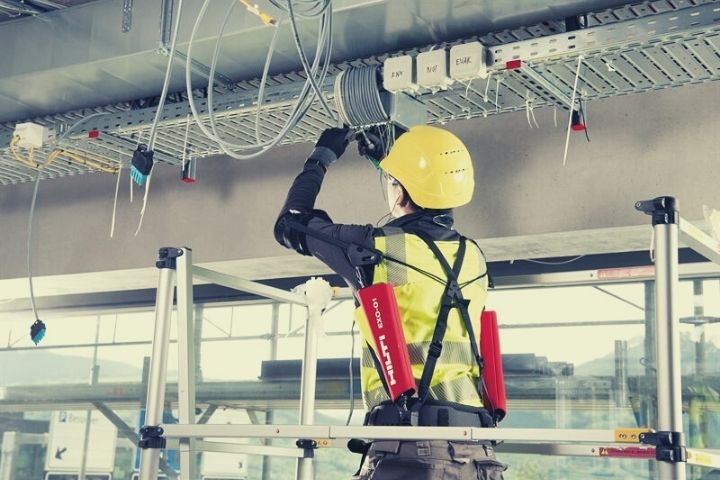The concept of exoskeletons has been around for a long time, at least in sci-fi movies, but exoskeletons are starting to have real world applications and are no longer the dream of Hollywood movies. Because the construction industry involves a lot of heavy lifting, moving, and gripping, this technology is ideal for proving its usefulness; it improves the safety, work rate, and efficiency of onsite workers.
It’s not just the heavy lifting that impacts the human body, it is also the repetitive jobs that can accumulate over time and cause injuries like repetitive strain injury. Exoskeletons can help with many tasks in the industrial world, such as drilling into walls, holding heavy drills, or screwing in bolts overhead, while having to keep the arms elevated for a length of time. By supporting the workers’ back, legs, and arms, in fact the entire body, these exoskeletons will increasingly be seen on construction sites all over the world.
Table of Contents
The Basics Of Exoskeletons
Wearable machines that come with motorised joints fall into two basic categories: mechanical exoskeletons and electrical exoskeletons. Their main intended functions are to assist with lifting, weight dispersion, and correcting poor posture.
Although the current primary use for exoskeletons is for physical rehabilitation, they are being used more and more by construction workers to do heavy and mundane tasks, reducing the load on the human body. Wearable technologies like exoskeletons are predicted to significantly increase in the coming years, according to the 2018 Commercial Construction Index.
Depending on the suits’ intended function, they can be made from a variety of materials like metal, or softer materials like textiles. Mechanical exoskeletons do not require any electric power to operate. A major benefit of this type is that they don’t require charging nor the need to carry around a battery power source. Mechanical suits usually work on the principle of weight distribution, by spreading the load from areas like the arms or shoulders and placing it on more sturdy areas like the waist or core.
Electrical exoskeleton wearables can be fully or partially powered by electricity, and because of this, they are normally more powerful than mechanical ones, meaning they can handle more weight and heavy lifting. They can target specific body areas, like the hands, shoulders, or legs, and focus strength and power where it is needed the most.
These are very useful and powerful pieces of equipment, but they do come with the disadvantage of requiring power to operate them, meaning there is a time and cost implication to consider. The battery will have to be recharged or the suit battery will have to be changed, and when changing the battery, the suit will have to cool down first. Furthermore, the batteries will add extra weight to the suits, potentially restricting movement and where they can be used.
Benefits Of Using Exoskeletons In Construction
Construction work entails a lot of heavy lifting and potentially dangerous tasks are involved, as clearly demonstrated by industry statistics on safety and injuries to workers on site, and some exoskeletons are designed specifically with this in mind. For example, exoskeletons are very good at lessoning the pressure on the spine and helping with reducing the likelihood of fatigue, a major cause of concern in causing injuries on construction sites.
By helping to reduce injury and strain, exoskeletons work by redistributing weight to reduce the load on certain parts of the body, such as shoulders and back. This will help reduce the risk of both acute injuries and developing long-term injuries from repetitive strain injuries. By reducing the likelihood of work-related fatigue, they can assist with increasing productivity and work rate.
Exoskeletons also hold the potential to increase employment opportunities for those that may not have been able to do physical labour previously but can now with mechanical assistance.
Different Types Of Exoskeletons
Exoskeleton suits come in all shapes and sizes, all of which are designed for specific uses and for specific body parts. Examples include power gloves, arm and shoulder supports, back support, standing and crouching supports, and all the way up to whole body suits.
Power gloves are very useful for gripping tools and materials, something that is a constant task performed on construction sites. By improving the hand grip strength, they can also improve dexterity and help those with weakness in grasping tools. Some models have sensors installed to learn the user’s natural movements, adjusting the grip power when it detects the user is about to grip an object.
As the name suggests, whole-body suits give support throughout the entire body. Their focus is on minimising body strain and maximising productivity by enhancing human strength, dexterity, and capability. Whole-body suits can be either mechanical or electrical, with some being a combination of the two.
Given the advances in robotics in recent years, such as demonstrated with robots being created by Boston Dynamics, and military technologies (like DARPA), it’s not too difficult to imagine that even these exoskeleton suits won’t be needed in the near future as AI powered robots will enter the construction scene.
